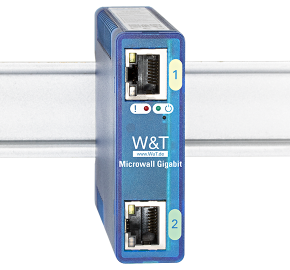Microwall Gigabit
Secure islands (separate yet connected)
The Microwall routes your device islands securely and easily into the corporate intranet. Simple and intuitive selectable filter rules protect sensitive island communication from damaging events in the intranet as well as guarding against undesired access.
Properties
Interfaces:
- 2x Ethernet 100/1000BaseT
- Autosensing/Auto-MDIX
Management and connectivity:
- Remote configuration
- Simply startup via WuTility or DHCP
- Secure Web-based management using HTTPS only
- All service/management services can be disabled
- Mode: Standard router
- Integration into the routing concept of the intranet
- Mode: NAT router
- Integration of the islands via a single Intranet IP
- Whitelist-based firewall
- Filter rules based on IPv4 addresses and TCP/UDP port numbers
- Logging
- Identification of undesired communication attempts
- Increased data throughput
- Network connection via Gigabit-Ethernet
- High-performance hardware platform for less latencies
Power supply:
- External power
- Screw terminals, 24V-48V DC
- Power-over-Ethernet (PoE)
- Phantom power using data pairs
- Power over unused wire pairs
Standards & more
- Conforms to standards both in office and industrial environments:
- High noise resistance per EN 61000-6-2
- Low noise emission per EN 55032:2015 + A1 Cl. B, EN 61000-3-2 & EN 61000-3-3
- 5 year guarantee
Run modes
The Microwall moves sensitive components or sub-networks into a separate island network and in that way separates it from the higher level corporate intranet. Connections over the Microwall must be given an express release using rules based on source/destination IP and the needed TCP/UDP port numbers. Communication with documented and/or undesired services is prevented and damaging events such as overload are kept away from the island.
NAT router mode
Similar to a traditional DSL internet connection, the entire island network is incorporated into the network there via an IP address for the intranet page. No access into the routing concept of the intranet is required. Operating multiple island networks with the same IP areas is also possible in this mode. Machine and systems builders are therefore able to run internal networks with a uniform series IP configuration - no cumbersome modifications to the customer infrastructure.
Standard router mode
The Microwall acts as a traditional router and the island network is made known in the intranet for example in the form of static routes.
Filter rules
Microwall rules are simply and clearly managed using Web Based Management and are fully Whitelist based. This means any communication which is not expressly enabled in the form of a rule is blocked.
Technical data
Connections and displays:
- Network:
- 2x 100/1000BaseT Autosensing/Auto-MDIX
- RJ45
- IPv6 on request
- Galvanic isolation:
- Network connections min. 1500 V
- Power supply:
- Power-over-Ethernet (PoE) or
- DC 24V .. 48V (+/-10%) and
- AC 18Veff .. 30Veff (+/-10%)
- Supply connection:
- Plug-in screw terminal, 5.08mm spacing
- Labeled "L+" and "M"
- Current consumption:
- PoE Class 2 (3.84 W to 6.49 W)
- or for external supply:
- typ. 150mA @24V DC
- max. 200mA @24VDC
- Indicators:
- 2x LEDs for network status
- 1x LED for Error
Housing and other data:
- Enclosure:
- Plastic compact housing for top-hat rail mount
- 105x22x75mm (LxWxH)
- Enclosure rating:
- IP20
- Weight:
- approx. 120g
- Ambient temperature:
- Storage: -40..+85°C
- Operating 0..+50°C (no stack mounting)
- Permissible relative humidity:
- 5..95% RH, non-condensing
- Scope of delivery:
- 1x Microwall Gigabit
- 1x Quick Guide
